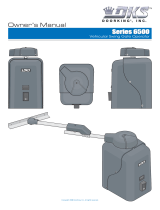Page is loading ...

120 Glasgow Avenue
Inglewood, California 90301
U.S.A.
Copyright 2011 DoorKing, Inc. All rights reserved.
The Model 1878 is used to protect electronic equipment powered by 6 to 24 volts AC or DC. The surge suppressor may be sacrificed
during an “extreme” power spike to protect the equipment. Protection is acrossed the power lines and from each line to ground. The
clamping voltage is approximately 50 volts. DO NOT connect to power lines over 24 VAC. Maximum current is 10 amps.
24 V POWER LINE SURGE SUPPRESSOR
Installation of the Surge Suppressor
Grounding the Surge Suppressor
DoorKing Part Number
1878-010
1878-065-B-1-11
Acceptable Grounding: The importance of providing a good ground cannot be over emphasized. The grounding point should be
close to the equipment being protected. This will provide a quick path to ground for any power surge or spike. Locate the surge
suppressor as close as possible (within 3 ft) to the grounding point. DO NOT place the surge suppressor far away from the
grounding point.
Ideally, it is recommended to provide a good grounding rod for a gate operator or a telephone entry system and all related
components. The NEC recommends that the grounding rod be a copper clad rod, no smaller than 5/8” in diameter and no less than
8’ in length, with a minimum of 8’ buried in the ground. Check with local regulations for specifications on the grounding rod.
Unacceptable Grounding: A metal fence post, goose neck mounting post or metal frame of a gate operator is not considered an
earth ground. These items are generally not deep enough in the ground and/or are insulated from the ground by concrete.
Utilize a Single Point Ground for Multiple Equipment: Provide a Ground Bus to connect all grounds to the local grounding rod
when grounding multiple devices. This includes Case Ground, Electrical Ground, Surge Suppression Grounds, etc.
Existing Electrical Supply Panel Ground: Utilizing the “Green Wire” from an existing electrical panel may result in performance
related problems:
1. Telephone Entry Systems - The “Green Wire” from the existing electrical panel may carry a 60 Hz “Hum”, inducing noise
into the phone entry system.
2. Surge Suppressor Ground - The “Green Wire” from the existing electrical panel is typically not close enough to provide
proper electrical dissipation to the ground during an extreme power surge.
Good Mounting Rule: DO NOT place the surge suppressor INSIDE the equipment you are trying to protect. If placed INSIDE the
equipment, you will be routing the “potential lightning voltage” directly to the equipment BEFORE it can go to the grounding source.
If the surge suppressor is installed outdoors, use a water protected enclosure (not supplied) to protect the surge suppressor from
direct exposure to landscape sprinklers, rain, snow and other elements.
Important Note: A common
problem is placing an
acceptable ground too far
away from the surge
suppressor. This will NOT
provide a quick path to the
ground for an electrical
power surge or spike.
Grounding Source within 3 ft of Surge Suppressor
(Grounding rod recommended)
Grounding Wires 12 AWG minimum
Ground within 3 ft.
POWER LINE
1878-010
Surge suppressor
within 10 ft of
equipment preferred.
Up to 24 VAC
Power Transformer
Wires from Power Transformer
(Polarity does not matter)
Wires to Equipment
Equipment
being protected.
(24 V max.)
24 V
1878-010
INPUT
24 V POWER LINE
GND GND 24 V
OUTPUT
24 V 24 V
Wire Size Max Distance
18 AWG
16 AWG
100 ft
200 ft
Power Transformer Wire Run
Total Distance
Wire Run Total Distance
/

